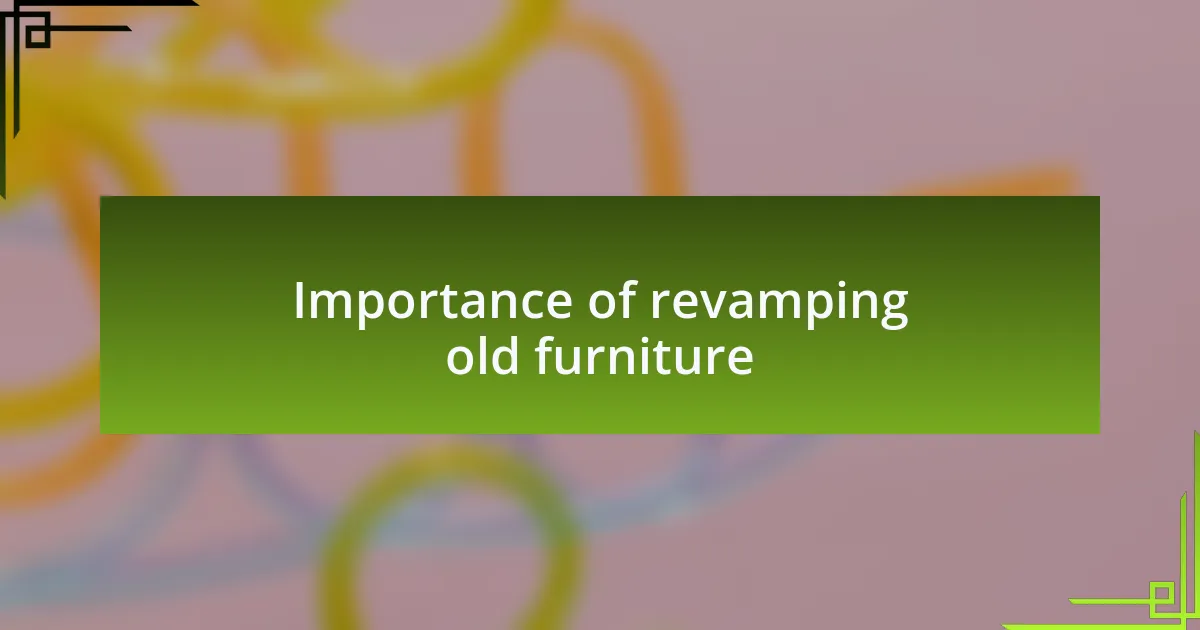Key takeaways:
- Arts and crafts events foster creativity, community, and personal growth through shared experiences and skills development.
- Revamping old furniture promotes sustainability and allows for personal expression, transforming items into unique reflections of one’s identity.
- Key revamping techniques include painting, decoupage, and upholstery, each providing opportunities for creativity and emotional connection.
- Successful revamping requires planning, selecting the right tools, and embracing imperfections as part of the creative journey.

Arts and crafts events overview
Arts and crafts events provide a unique opportunity for individuals to unleash their creativity and connect with like-minded enthusiasts. I remember my first community craft fair—it was buzzing with energy, and I felt an immediate sense of belonging as I explored booths brimming with handmade treasures. Have you ever walked through an event and felt an overwhelming sense of inspiration?
Participating in these events not only allows for the exchange of ideas but also encourages personal growth and the development of new skills. I once attended a pottery workshop at a local festival, where I discovered a love for molding clay that I never knew I had. It made me realize how stepping out of my comfort zone can lead to unexpected passions.
These gatherings also foster a sense of community. They create spaces where stories of creativity flourish and individuals share their journeys, often revealing how a simple hobby can transform into a lifelong passion. Isn’t it remarkable how a collective appreciation for art can bring so many diverse people together?

Importance of revamping old furniture
Revamping old furniture is a powerful act of storytelling. Each piece carries its own history, and when I decided to restore my grandmother’s rocking chair, I felt a deep connection to my past. As I sanded down the old paint, I uncovered the layers of memories embedded in its worn wood. It made me wonder: how many stories does your furniture hold that are just waiting to be revived?
By breathing new life into old items, we practice sustainability and reduce waste. I recall transforming a thrift store dresser into a vibrant display for my plants—a project that not only beautified my space but also offered a sense of accomplishment. Isn’t it fulfilling to know that every stroke of paint is a step towards a greener planet?
Moreover, revamping furniture allows for personal expression. I once reupholstered a vintage armchair, selecting fabrics that reflected my taste and style. The transformation was not just visual; it became a reflection of my personality. How often do we find joy in creating something that feels uniquely ours? Revamping isn’t merely about aesthetics; it’s a declaration of identity.

Types of revamping techniques
When it comes to revamping old furniture, one popular technique is painting. I vividly remember taking a tired, wooden side table and giving it a fresh coat of bright turquoise. Each brushstroke was exhilarating, and seeing that piece transform before my eyes filled me with pride. Have you ever experienced the thrill of watching something dull metamorphose into a vibrant focal point in your space?
Another method I’ve embraced is decoupage. I will never forget the time I took an outdated coffee table and adorned it with beautiful magazine clippings and fabric squares. The process was therapeutic, and the final result was not only visually stunning but also a unique conversation starter. It’s amazing how something as simple as layering paper can create such depth and character, don’t you think?
Finally, I have dabbled in upholstery, which truly offers a chance to express oneself. A while back, I entirely reupholstered a dated chaise lounge with a bold floral fabric. The joy I felt in choosing the material and watching that old piece come to life was indescribable. Have you thought about how upholstery can completely change the feel of your home? The experience taught me that the right fabric can not only revitalize furniture but also evoke emotions and memories, wrapping them in comfort.

Materials needed for revamping
When revamping old furniture, gathering the right materials is crucial. For instance, I always make sure to have quality paint and brushes on hand. I remember one time I used a high-gloss paint that really made a small dresser shine like new—how rewarding it was to see the luster come alive!
Aside from paint, a good pair of scissors and decoupage glue are essentials for layering designs. I still recall the satisfaction of meticulously cutting out images from vintage books, finding the perfect ones to complement my old nightstand. It’s fascinating how just a bit of glue can bond different elements together, isn’t it?
If you’re tackling upholstery, don’t forget a staple gun and foam padding. I learned this the hard way when I tried to use an old cushion without replacing it. The moment I added fresh foam to an armchair, it was like sitting on a cloud. Have you ever experienced that lovely contrast between worn-out and revitalized? It’s through these materials that the transformation truly begins.

My favorite revamping projects
One of my most cherished revamping projects was a tired-looking coffee table that had seen better days. After stripping off the old veneer, I opted for a bold turquoise paint that infused new life into my living room. I’ll never forget the moment I set it back in place; it felt like I had unearthed a hidden treasure, brightening up the entire space.
Another project that stands out is my shabby-chic dresser, which was mostly collecting dust in a corner. I decided to go for a distressed look, layering soft beige with white to achieve that perfect worn effect. It was so thrilling to sand the edges and reveal subtle hints of the base coat—did you know that little touches like these can totally change the character of a piece?
Lastly, I took on an old wood chair that had lost its charm. By reupholstering it in a vibrant floral fabric, not only did I give it a modern twist, but I also felt a deep sense of accomplishment. Have you ever taken something forgotten and turned it into a statement piece? It’s moments like these that remind me of the joy and creativity inherent in revamping furniture.

Challenges in furniture revamping
Revamping old furniture is rewarding, but it comes with its own set of challenges. For instance, when I attempted to strip paint from an antique side table, I realized not all finishes react well to the same methods. The peeling turned into a real headache; I learned that patience is key. Have you ever tackled a stubborn surface?
One of the most frustrating aspects I encountered was sourcing quality materials. I remember driving from one craft store to another, hunting for the perfect knobs for a revamped cabinet. It was disheartening when I didn’t find what I envisioned. This searching often takes more time than expected, but it reinforces the idea that every detail contributes to the final outcome.
Additionally, there’s always the risk of overestimating my skills. When I decided to try a complex technique such as layering stains, I found myself facing unexpected challenges that tested my DIY confidence. Learning to adapt and keep my creative spirit alive during those moments has taught me a lot about resilience. I wonder, how do you handle setbacks in your creative projects?

Tips for successful revamping
When I revamp furniture, I find it crucial to plan ahead, even if that sounds like a basic step. I remember once diving headfirst into a project without a clear vision, only to discover halfway through that I didn’t have a cohesive color scheme. I learned the hard way that sketching out ideas can save time and disappointment later. Have you ever started a project only to feel lost among your materials?
Selecting the right tools is another important tip. The first time I attempted to reupholster a chair, I dove right in without a decent staple gun. I quickly realized that the right tools not only make the process easier but also enhance the quality of the final product. Thinking back, I question how much smoother that project could have been with just a few more essentials at my side.
Lastly, I always remind myself to embrace imperfections. While refinishing a vintage dresser, I was devastated when a minor flaw appeared in the finish. Instead of letting it ruin the project, I turned it into a design feature, adding a bit of character. It made me wonder, how often do we overlook the beauty in the quirks of our creations? Each piece tells its own story, and those little imperfections can make it uniquely ours.